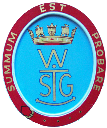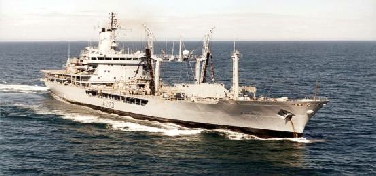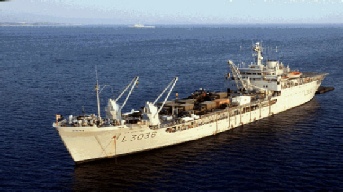Weapons Systems Tuning Group Reunion

© WSTG Reunion Committee 2016
Go to top of page
Dick Barton
WSTG & The Royal Fleet Auxiliary

D uring the 1960’s The Royal Navy underwent another of those post World War II reviews that challenged the role and purpose of the fleet. It was recognised that the UK could not afford to maintain the overseas dockyards and depots on which a worldwide deployment of RN vessels depended. One outcome was the formation in 1965 of the Royal Naval Supply and Transport Service (RNSTS). The Service was tasked with supplying and replenishing the RN fleet with victualling, fuel and materiel (including munitions) -
uring the 1960’s The Royal Navy underwent another of those post World War II reviews that challenged the role and purpose of the fleet. It was recognised that the UK could not afford to maintain the overseas dockyards and depots on which a worldwide deployment of RN vessels depended. One outcome was the formation in 1965 of the Royal Naval Supply and Transport Service (RNSTS). The Service was tasked with supplying and replenishing the RN fleet with victualling, fuel and materiel (including munitions) -
Many of the ships were simply taken up on long lease from tanker or freight companies but several were especially designed and built for the RNSTS. All were painted grey. The ships were grouped a little like RN ships: the 6 Olwen & Tide class large fleet tankers, the 5 smaller Rover class tankers, the 3 warehouse like Ness class, the 5 freighting tankers of the Leaf class and the larger Dewdale. The Resurgent and the Resource – these ships were equipped to replenish two warships simultaneously. The smaller Hebe and Bacchus cargo carriers. The Empire Gull used almost exclusively to support Army needs. The 6 Sir class LSL’s named after the Knights of the Round Table. Some other notable names were ships such as: The Engadine – a helicopter training ship designed to introduce flyers to the unique hazard of landing on a flight deck. The Reliant – used to move some very sensitive equipment during the Polaris project. The Fort class came into service and so on. Unfortunately, some of the more recent vessels (who are best left unnamed) have not necessarily developed the same regard and affection experienced by the original fleet – but then the RNSTS is no more and the task objectives have been radically changed – that is progress.
These ships were in virtually continuous use, manned by members of the UK Merchant Navy with a special outfit of non-
The RFA refit was regarded by the RNTS as wasted support time. Not un-
Meanwhile, WSTG specialist staff were operating in the major ship build yards working on the new construction warships. Many of these yards were adjacent to RFA’s undergoing refit. RFA Radio Officers would often make contact and seek advice on equipment and installation problems. Soon the help became more significant than a simple pint at the pub could possibly repay.
It was Leslie Marks (a senior grade within the WSTG administration) who came up with the simple solution – because WSTG already had staff with the specialist skills imbedded in the refit areas – WSTG would do everything. Fleet standards would be better maintained -
The arrangement became formal and WSTG adopted RFA RN equipment as part of the planned work commitment in 1975. That year I joined WSTG and found myself assigned to Dennis Jones (a Tech-
The WSTG commitment to RFA’s was extensive. The preparation for a refit required the RFA to declare the status of all Common Range Electronic Test Equipment (CRETE) held on board. WSTG identified the equipment essential to maintain the necessary calibration control standards. Those items would be demanded from the central Calibration Service and arrangements made to rendezvous with the RFA during the early days of the pre-
Not everything was as simple as it seemed. The RNSTS made an art form of keeping the identity of the successful refit contractor secret until the very last minute. Rumour had it that ships were known to sail from a de-
It was not just maintaining an established installation that made demands on the arrangement. There were occasions when major alterations meant that large portions of the Radio Office would be stripped out and replaced with entirely new equipment, which then, had to interface with the remainder of the system. This installation trauma was often conducted at breakneck speed by the ship repairer because he would not wish to incur any delay penalties. Add to this and notwithstanding the best intentions of the design authority, it was often necessary for a select team of WSTG staff (who had an innate talent for identifying interface bugs) to apply fixes without which the systems would never have worked.
When all refit work was complete, WSTG would conduct full Harbour Acceptance trials once more to ensure the equipment met full RN functionality and maintainability standards. Quite often it would be impossible to carry out these trials in a ship repair yard because the conditions and environment were unsuitable so, it would become necessary to visit the ship during the re-
The dominant remit for an RFA was to be able to maintain radio contact with MOD headquarters and with the fleet. This required the RFA to carry equipment comparable to a warship and that included the encryption mechanisms associated with those communication systems. As a consequence, Tempest testing on completion of all the refit work was an essential task, which again was a service, provided by WSTG and which invariably was carried out in the electronically secure environment of a Royal Dockyard.
Over the years this comprehensive and exclusive service provided by WSTG came under scrutiny, as did the ownership and administration of the group within MOD – needless to say the service became ‘rationalised’ and some major aspects curtailed. Even so, the RFA’s continue in service and the remnants of staff that remain have retained some of the original WSTG capability and so continue with the good work.
comprehensive and exclusive service provided by WSTG came under scrutiny, as did the ownership and administration of the group within MOD – needless to say the service became ‘rationalised’ and some major aspects curtailed. Even so, the RFA’s continue in service and the remnants of staff that remain have retained some of the original WSTG capability and so continue with the good work.
(db) December 2004